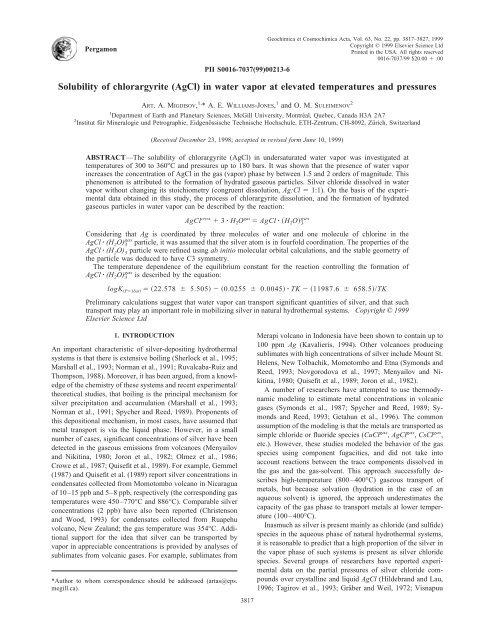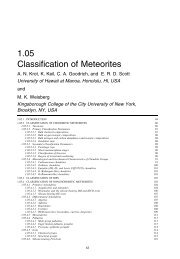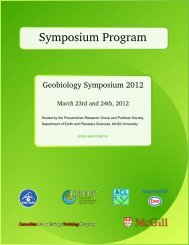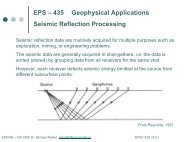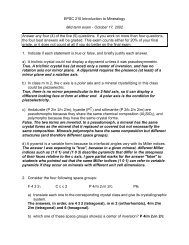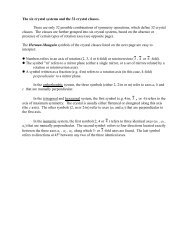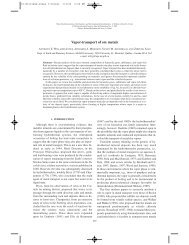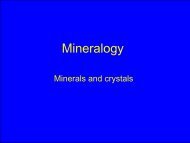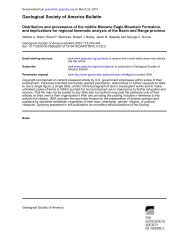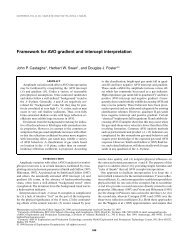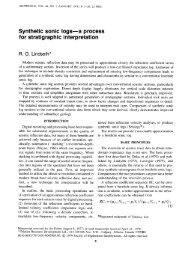Solubility of chlorargyrite (AgCl) in water vapor at elevated ...
Solubility of chlorargyrite (AgCl) in water vapor at elevated ...
Solubility of chlorargyrite (AgCl) in water vapor at elevated ...
Create successful ePaper yourself
Turn your PDF publications into a flip-book with our unique Google optimized e-Paper software.
Pergamon<br />
PII S0016-7037(99)00213-6<br />
Geochimica et Cosmochimica Acta, Vol. 63, No. 22, pp. 3817–3827, 1999<br />
Copyright © 1999 Elsevier Science Ltd<br />
Pr<strong>in</strong>ted <strong>in</strong> the USA. All rights reserved<br />
0016-7037/99 $20.00 .00<br />
<strong>Solubility</strong> <strong>of</strong> <strong>chlorargyrite</strong> (<strong>AgCl</strong>) <strong>in</strong> <strong>w<strong>at</strong>er</strong> <strong>vapor</strong> <strong>at</strong> elev<strong>at</strong>ed temper<strong>at</strong>ures and pressures<br />
ART. A.MIGDISOV, 1, *A.E.WILLIAMS-JONES, 1 and O. M. SULEIMENOV 2<br />
1 Department <strong>of</strong> Earth and Planetary Sciences, McGill University, Montréal, Quebec, Canada H3A 2A7<br />
2 Institut für M<strong>in</strong>eralogie und Petrographie, Eidgenössische Technische Hochschule, ETH-Zentrum, CH-8092, Zürich, Switzerland<br />
(Received December 23, 1998; accepted <strong>in</strong> revised form June 10, 1999)<br />
ABSTRACT—The solubility <strong>of</strong> <strong>chlorargyrite</strong> (<strong>AgCl</strong>) <strong>in</strong> unders<strong>at</strong>ur<strong>at</strong>ed <strong>w<strong>at</strong>er</strong> <strong>vapor</strong> was <strong>in</strong>vestig<strong>at</strong>ed <strong>at</strong><br />
temper<strong>at</strong>ures <strong>of</strong> 300 to 360 o C and pressures up to 180 bars. It was shown th<strong>at</strong> the presence <strong>of</strong> <strong>w<strong>at</strong>er</strong> <strong>vapor</strong><br />
<strong>in</strong>creases the concentr<strong>at</strong>ion <strong>of</strong> <strong>AgCl</strong> <strong>in</strong> the gas (<strong>vapor</strong>) phase by between 1.5 and 2 orders <strong>of</strong> magnitude. This<br />
phenomenon is <strong>at</strong>tributed to the form<strong>at</strong>ion <strong>of</strong> hydr<strong>at</strong>ed gaseous particles. Silver chloride dissolved <strong>in</strong> <strong>w<strong>at</strong>er</strong><br />
<strong>vapor</strong> without chang<strong>in</strong>g its stoichiometry (congruent dissolution, Ag:Cl 1:1). On the basis <strong>of</strong> the experimental<br />
d<strong>at</strong>a obta<strong>in</strong>ed <strong>in</strong> this study, the process <strong>of</strong> <strong>chlorargyrite</strong> dissolution, and the form<strong>at</strong>ion <strong>of</strong> hydr<strong>at</strong>ed<br />
gaseous particles <strong>in</strong> <strong>w<strong>at</strong>er</strong> <strong>vapor</strong> can be described by the reaction:<br />
<strong>AgCl</strong> cryst. 3 H 2 O gas <strong>AgCl</strong> H 2 O 3<br />
gas<br />
Consider<strong>in</strong>g th<strong>at</strong> Ag is coord<strong>in</strong><strong>at</strong>ed by three molecules <strong>of</strong> <strong>w<strong>at</strong>er</strong> and one molecule <strong>of</strong> chlor<strong>in</strong>e <strong>in</strong> the<br />
<strong>AgCl</strong> (H 2 O) 3 gas particle, it was assumed th<strong>at</strong> the silver <strong>at</strong>om is <strong>in</strong> fourfold coord<strong>in</strong><strong>at</strong>ion. The properties <strong>of</strong> the<br />
<strong>AgCl</strong> (H 2 O) 3 particle were ref<strong>in</strong>ed us<strong>in</strong>g ab <strong>in</strong>itio molecular orbital calcul<strong>at</strong>ions, and the stable geometry <strong>of</strong><br />
the particle was deduced to have C3 symmetry.<br />
The temper<strong>at</strong>ure dependence <strong>of</strong> the equilibrium constant for the reaction controll<strong>in</strong>g the form<strong>at</strong>ion <strong>of</strong><br />
<strong>AgCl</strong> (H 2 O) 3 gas is described by the equ<strong>at</strong>ion:<br />
logK P1bar 22.578 5.505 0.0255 0.0045 TK 11987.6 658.5/TK<br />
Prelim<strong>in</strong>ary calcul<strong>at</strong>ions suggest th<strong>at</strong> <strong>w<strong>at</strong>er</strong> <strong>vapor</strong> can transport significant quantities <strong>of</strong> silver, and th<strong>at</strong> such<br />
transport may play an important role <strong>in</strong> mobiliz<strong>in</strong>g silver <strong>in</strong> n<strong>at</strong>ural hydrothermal systems. Copyright © 1999<br />
Elsevier Science Ltd<br />
1. INTRODUCTION<br />
An important characteristic <strong>of</strong> silver-deposit<strong>in</strong>g hydrothermal<br />
systems is th<strong>at</strong> there is extensive boil<strong>in</strong>g (Sherlock et al., 1995;<br />
Marshall et al., 1993; Norman et al., 1991; Ruvalcaba-Ruiz and<br />
Thompson, 1988). Moreover, it has been argued, from a knowledge<br />
<strong>of</strong> the chemistry <strong>of</strong> these systems and recent experimental/<br />
theoretical studies, th<strong>at</strong> boil<strong>in</strong>g is the pr<strong>in</strong>cipal mechanism for<br />
silver precipit<strong>at</strong>ion and accumul<strong>at</strong>ion (Marshall et al., 1993;<br />
Norman et al., 1991; Spycher and Reed, 1989). Proponents <strong>of</strong><br />
this depositional mechanism, <strong>in</strong> most cases, have assumed th<strong>at</strong><br />
metal transport is via the liquid phase. However, <strong>in</strong> a small<br />
number <strong>of</strong> cases, significant concentr<strong>at</strong>ions <strong>of</strong> silver have been<br />
detected <strong>in</strong> the gaseous emissions from volcanoes (Menyailov<br />
and Nikit<strong>in</strong>a, 1980; Joron et al., 1982; Olmez et al., 1986;<br />
Crowe et al., 1987; Quisefit et al., 1989). For example, Gemmel<br />
(1987) and Quisefit et al. (1989) report silver concentr<strong>at</strong>ions <strong>in</strong><br />
condens<strong>at</strong>es collected from Momotombo volcano <strong>in</strong> Nicaragua<br />
<strong>of</strong> 10–15 ppb and 5–8 ppb, respectively (the correspond<strong>in</strong>g gas<br />
temper<strong>at</strong>ures were 450–770°C and 886°C). Comparable silver<br />
concentr<strong>at</strong>ions (2 ppb) have also been reported (Christenson<br />
and Wood, 1993) for condens<strong>at</strong>es collected from Ruapehu<br />
volcano, New Zealand; the gas temper<strong>at</strong>ure was 354°C. Additional<br />
support for the idea th<strong>at</strong> silver can be transported by<br />
<strong>vapor</strong> <strong>in</strong> appreciable concentr<strong>at</strong>ions is provided by analyses <strong>of</strong><br />
sublim<strong>at</strong>es from volcanic gases. For example, sublim<strong>at</strong>es from<br />
*Author to whom correspondence should be addressed (artas@eps.<br />
megill.ca).<br />
3817<br />
Merapi volcano <strong>in</strong> Indonesia have been shown to conta<strong>in</strong> up to<br />
100 ppm Ag (Kavalieris, 1994). Other volcanoes produc<strong>in</strong>g<br />
sublim<strong>at</strong>es with high concentr<strong>at</strong>ions <strong>of</strong> silver <strong>in</strong>clude Mount St.<br />
Helens, New Tolbachik, Momotombo and Etna (Symonds and<br />
Reed, 1993; Novgorodova et al., 1997; Menyailov and Nikit<strong>in</strong>a,<br />
1980; Quisefit et al., 1989; Joron et al., 1982).<br />
A number <strong>of</strong> researchers have <strong>at</strong>tempted to use thermodynamic<br />
model<strong>in</strong>g to estim<strong>at</strong>e metal concentr<strong>at</strong>ions <strong>in</strong> volcanic<br />
gases (Symonds et al., 1987; Spycher and Reed, 1989; Symonds<br />
and Reed, 1993; Getahun et al., 1996). The common<br />
assumption <strong>of</strong> the model<strong>in</strong>g is th<strong>at</strong> the metals are transported as<br />
simple chloride or fluoride species (CuCl gas , <strong>AgCl</strong> gas , CsCl gas ,<br />
etc.). However, these studies modeled the behavior <strong>of</strong> the gas<br />
species us<strong>in</strong>g component fugacities, and did not take <strong>in</strong>to<br />
account reactions between the trace components dissolved <strong>in</strong><br />
the gas and the gas-solvent. This approach successfully describes<br />
high-temper<strong>at</strong>ure (800–400°C) gaseous transport <strong>of</strong><br />
metals, but because solv<strong>at</strong>ion (hydr<strong>at</strong>ion <strong>in</strong> the case <strong>of</strong> an<br />
aqueous solvent) is ignored, the approach underestim<strong>at</strong>es the<br />
capacity <strong>of</strong> the gas phase to transport metals <strong>at</strong> lower temper<strong>at</strong>ure<br />
(100–400°C).<br />
Inasmuch as silver is present ma<strong>in</strong>ly as chloride (and sulfide)<br />
species <strong>in</strong> the aqueous phase <strong>of</strong> n<strong>at</strong>ural hydrothermal systems,<br />
it is reasonable to predict th<strong>at</strong> a high proportion <strong>of</strong> the silver <strong>in</strong><br />
the <strong>vapor</strong> phase <strong>of</strong> such systems is present as silver chloride<br />
species. Several groups <strong>of</strong> researchers have reported experimental<br />
d<strong>at</strong>a on the partial pressures <strong>of</strong> silver chloride compounds<br />
over crystall<strong>in</strong>e and liquid <strong>AgCl</strong> (Hildebrand and Lau,<br />
1996; Tagirov et al., 1993; Gräber and Weil, 1972; Visnapuu
3818 A. A. Migdisov, A. E. Williams-Jones, and O. M. Suleimenov<br />
and Jensen, 1970; Chang and Toguri, 1974), but published d<strong>at</strong>a<br />
on the behavior <strong>of</strong> silver <strong>in</strong> <strong>w<strong>at</strong>er</strong> <strong>vapor</strong> are restricted to ab<br />
<strong>in</strong>itio calcul<strong>at</strong>ions (Mart<strong>in</strong>ez et al., 1997; Shevkunov, 1996;<br />
Shevkunov and Al’mukhrez, 1994). These l<strong>at</strong>ter studies have<br />
predicted the coord<strong>in</strong><strong>at</strong>ion <strong>of</strong> silver <strong>in</strong> the first and second<br />
hydr<strong>at</strong>ion shells, and have estim<strong>at</strong>ed the energy <strong>of</strong> hydr<strong>at</strong>ion,<br />
but they have not deduced the basic thermodynamic properties<br />
<strong>of</strong> the silver compounds <strong>in</strong> the <strong>vapor</strong> phase. The goal <strong>of</strong> the<br />
present work was to obta<strong>in</strong> thermodynamic <strong>in</strong>form<strong>at</strong>ion on<br />
soluble silver chloride species <strong>in</strong> <strong>w<strong>at</strong>er</strong> <strong>vapor</strong> <strong>at</strong> temper<strong>at</strong>ures<br />
up to 360°C and pressures up to 200 bars.<br />
2. EXPERIMENTAL METHOD<br />
The experimental method is similar to th<strong>at</strong> used by Migdisov et al.<br />
(1998). Experiments were carried out <strong>at</strong> temper<strong>at</strong>ures between 300 and<br />
360°C (Table 2) <strong>in</strong> an electric furnace (<strong>in</strong>ternal diameter 15 cm, height<br />
50 cm) equipped with large alum<strong>in</strong>um or copper walls to reduce<br />
temper<strong>at</strong>ure gradients. A thermal regul<strong>at</strong>or allowed the temper<strong>at</strong>ure to<br />
be controlled to an accuracy <strong>of</strong> approxim<strong>at</strong>ely 0.5°C. Before runs, the<br />
temper<strong>at</strong>ure gradient <strong>in</strong> the experimental system was measured with<br />
three thermocouples, loc<strong>at</strong>ed <strong>at</strong> the top, bottom, and center <strong>of</strong> the<br />
furnace. The vertical temper<strong>at</strong>ure gradient dur<strong>in</strong>g a run was typically <strong>in</strong><br />
the range 1.0 to 2.5°C/m, but dur<strong>in</strong>g the first 2 to 3hitwasbetween 8<br />
and 20°C/m due to the <strong>in</strong>itially cold st<strong>at</strong>e <strong>of</strong> the autoclave. Temper<strong>at</strong>ure<br />
dur<strong>in</strong>g runs was measured with two chromel-alumel thermocouples,<br />
loc<strong>at</strong>ed <strong>in</strong> the top and bottom <strong>of</strong> the furnace.<br />
The experiments were performed <strong>in</strong> titanium autoclaves, and <strong>in</strong>volved<br />
measur<strong>in</strong>g the solubility <strong>of</strong> synthetic <strong>chlorargyrite</strong> (<strong>AgCl</strong>) <strong>in</strong><br />
<strong>w<strong>at</strong>er</strong> <strong>vapor</strong>. The autoclaves were constructed from titanium alloy<br />
(grade 2 ASTM B348, Fig. 1). Each autoclave was conditioned <strong>in</strong>itially<br />
with nitric acid to produce a protective layer <strong>of</strong> TiO 2 on the <strong>in</strong>ternal<br />
surface. Autoclave volumes (100 cm 3 ) were determ<strong>in</strong>ed by fill<strong>in</strong>g the<br />
autoclaves with 25°C distilled <strong>w<strong>at</strong>er</strong> from a Teflon flask, and weigh<strong>in</strong>g<br />
this flask before and after fill<strong>in</strong>g. The weigh<strong>in</strong>g was performed to an<br />
accuracy 0.1 g. Autoclaves were loaded with pre-weighed pl<strong>at</strong><strong>in</strong>um<br />
or quartz ampoules conta<strong>in</strong><strong>in</strong>g s<strong>in</strong>gle crystals <strong>of</strong> <strong>AgCl</strong> (nitr<strong>at</strong>e, copper,<br />
and iron concentr<strong>at</strong>ions 0.001%).<br />
The ampoule was suspended near the top <strong>of</strong> the autoclave us<strong>in</strong>g a<br />
titanium spr<strong>in</strong>g or quartz needle (Fig. 1). A known mass <strong>of</strong> distilled<br />
nanopure <strong>w<strong>at</strong>er</strong> was placed <strong>in</strong> the bottom <strong>of</strong> the autoclave us<strong>in</strong>g a<br />
syr<strong>in</strong>ge <strong>in</strong> order to prevent contact <strong>of</strong> solid <strong>AgCl</strong> with liquid H 2 O. The<br />
mass <strong>of</strong> the <strong>w<strong>at</strong>er</strong> was determ<strong>in</strong>ed by weigh<strong>in</strong>g the syr<strong>in</strong>ge before and<br />
after <strong>in</strong>troduc<strong>in</strong>g the <strong>w<strong>at</strong>er</strong> <strong>in</strong>to the autoclave, and was accur<strong>at</strong>e to<br />
0.05 g. Care was taken to ensure th<strong>at</strong> the <strong>in</strong>troduced mass did not<br />
s<strong>at</strong>ur<strong>at</strong>e the system with liquid <strong>at</strong> the experimental conditions, and th<strong>at</strong><br />
<strong>AgCl</strong> solubility was restricted to the <strong>vapor</strong>. Due to the extremely low<br />
<strong>vapor</strong> pressure <strong>of</strong> silver chloride compared to th<strong>at</strong> <strong>of</strong> <strong>w<strong>at</strong>er</strong> <strong>vapor</strong>, the<br />
total pressure <strong>in</strong> a run was assumed to be equal to the pure <strong>w<strong>at</strong>er</strong> <strong>vapor</strong><br />
pressure, and was calcul<strong>at</strong>ed us<strong>in</strong>g the measured autoclave volume and<br />
the equ<strong>at</strong>ion <strong>of</strong> st<strong>at</strong>e for <strong>w<strong>at</strong>er</strong> <strong>of</strong> Kest<strong>in</strong> et al. (1984).<br />
Before each run, a current <strong>of</strong> nitrogen was passed through the<br />
autoclave for 20 to 40 m<strong>in</strong> to remove <strong>at</strong>mospheric gases. After the run,<br />
the autoclave was air-cooled down to room temper<strong>at</strong>ure, and the<br />
condens<strong>at</strong>es were collected as samples. The ampoule was dried <strong>at</strong><br />
120°C for 1 to 2htoremove <strong>w<strong>at</strong>er</strong> condensed on its walls and on the<br />
<strong>AgCl</strong> crystal, and was then re-weighed. <strong>AgCl</strong> condensed on the walls <strong>of</strong><br />
autoclave was dissolved us<strong>in</strong>g 3 to 7 ml <strong>of</strong> nitric acid (pH 0.5). The<br />
concentr<strong>at</strong>ions <strong>of</strong> dissolved silver <strong>in</strong> the condens<strong>at</strong>es and wash<strong>in</strong>g<br />
solutions were determ<strong>in</strong>ed by AA spectroscopy <strong>in</strong> graphite sample<br />
tubes us<strong>in</strong>g a Zeeman 5100 spectrometer (Perk<strong>in</strong> Elmer) and ICP-MS<br />
(Activ<strong>at</strong>ion Labor<strong>at</strong>ories Ltd., Ancaster, Canada).<br />
Due to the fact th<strong>at</strong> gaseous compounds with unusual stoichiometry<br />
are commonly described for solid-<strong>vapor</strong> systems (Gräber and Weil,<br />
1972; Visnapuu and Jensen, 1970; Chang and Toguri, 1974), the<br />
stoichiometry <strong>of</strong> the gaseous silver species was <strong>in</strong>vestig<strong>at</strong>ed by vary<strong>in</strong>g<br />
the quantity <strong>of</strong> HCl employed <strong>in</strong> experiments. The HCl was added <strong>in</strong><br />
quantities th<strong>at</strong> yielded solutions with pH values <strong>of</strong> 1.5, 2.5, 3.7, and 4.0.<br />
Experiments were carried out <strong>at</strong> pressures close to th<strong>at</strong> <strong>of</strong> s<strong>at</strong>ur<strong>at</strong>ed<br />
<strong>w<strong>at</strong>er</strong> <strong>vapor</strong> and <strong>at</strong> temper<strong>at</strong>ures <strong>of</strong> 330 and 360°C. Partial pressures <strong>of</strong><br />
Fig. 1. A section through a titanium autoclave <strong>of</strong> the type used <strong>in</strong> this<br />
study. The autoclave conta<strong>in</strong>s a <strong>chlorargyrite</strong>-bear<strong>in</strong>g pl<strong>at</strong><strong>in</strong>um capsule.<br />
HCl gas and <strong>w<strong>at</strong>er</strong> <strong>vapor</strong> <strong>in</strong> the runs were calcul<strong>at</strong>ed us<strong>in</strong>g the P-V-T<br />
rel<strong>at</strong>ions for hydrogen chloride-<strong>w<strong>at</strong>er</strong> mixtures <strong>at</strong> temper<strong>at</strong>ures up to<br />
500°C and pressures up to 1500 bars, reported by Bach et al. (1977).<br />
A potential source <strong>of</strong> error <strong>in</strong> the method is condens<strong>at</strong>ion <strong>of</strong> <strong>AgCl</strong> on<br />
the cold parts <strong>of</strong> the autoclave dur<strong>in</strong>g runs. The l<strong>at</strong>ter may occur if the<br />
chloragyrite is <strong>at</strong> a higher temper<strong>at</strong>ure than other <strong>in</strong>ternal parts <strong>of</strong> the<br />
autoclave, notably the walls, and could lead to considerable overestim<strong>at</strong>ion<br />
<strong>of</strong> the solubility <strong>of</strong> <strong>AgCl</strong> <strong>in</strong> the <strong>vapor</strong> phase. However, s<strong>in</strong>ce the<br />
autoclave was externally he<strong>at</strong>ed, it follows th<strong>at</strong> temper<strong>at</strong>ures were<br />
highest <strong>at</strong> the walls and lowest <strong>in</strong> the center, i.e., the chloragyrite was<br />
loc<strong>at</strong>ed <strong>in</strong> the coldest part <strong>of</strong> the autoclave. Thus, it is very unlikely th<strong>at</strong><br />
any condens<strong>at</strong>ion occurred dur<strong>in</strong>g he<strong>at</strong><strong>in</strong>g and <strong>at</strong> the experimental<br />
temper<strong>at</strong>ure. However, additional <strong>AgCl</strong> could have been released from<br />
the solid dur<strong>in</strong>g quench<strong>in</strong>g, and condensed on the cooler walls <strong>of</strong> the<br />
autoclave together with the <strong>AgCl</strong> which had been dissolved <strong>in</strong> <strong>vapor</strong> <strong>at</strong><br />
the end <strong>of</strong> the experiment. Another possible source <strong>of</strong> error is partition<strong>in</strong>g<br />
<strong>of</strong> <strong>AgCl</strong> from the <strong>vapor</strong> phase <strong>in</strong>to the liquid (<strong>w<strong>at</strong>er</strong>) dur<strong>in</strong>g<br />
he<strong>at</strong><strong>in</strong>g or quench<strong>in</strong>g. Ow<strong>in</strong>g to the much higher solubility <strong>of</strong> <strong>AgCl</strong> <strong>in</strong><br />
the liquid phase (several orders <strong>of</strong> magnitude higher), this could result<br />
<strong>in</strong> gross overestim<strong>at</strong>ion <strong>of</strong> the solubility <strong>of</strong> <strong>AgCl</strong> <strong>in</strong> the <strong>vapor</strong> phase.
<strong>Solubility</strong> <strong>of</strong> <strong>chlorargyrite</strong> <strong>in</strong> <strong>w<strong>at</strong>er</strong> <strong>vapor</strong><br />
3819<br />
Table 1. <strong>Solubility</strong> <strong>of</strong> <strong>AgCl</strong> <strong>in</strong> the <strong>vapor</strong> phase as a function <strong>of</strong> time.<br />
Time<br />
(days)<br />
T°C<br />
H 2 O<br />
(gr)<br />
P<br />
(bar)<br />
<strong>AgCl</strong><br />
(ppb)<br />
1 360 15 183 0.0<br />
2 360 15 183 5.3<br />
3 360 15 183 21.3<br />
4 360 15 183 50.8<br />
5 360 15 183 48.4<br />
6 360 15 183 63.3<br />
7 360 15 183 80.1<br />
8 360 15 183 86.6<br />
9 360 15 183 87.2<br />
10 360 15 183 81.1<br />
11 360 15 183 86.4<br />
1 300 4 81 0.0<br />
2 300 4 81 0.9<br />
3 300 4 81 0.0<br />
4 300 4 81 0.6<br />
5 300 4 81 1.4<br />
6 300 4 81 1.1<br />
7 300 4 81 1.7<br />
8 300 4 81 3.6<br />
9 300 4 81 4.4<br />
10 300 4 81 5.4<br />
11 300 4 81 5.0<br />
12 300 4 81 5.7<br />
13 300 4 81 5.1<br />
14 300 4 81 5.3<br />
15 300 4 81 5.3<br />
Experimental results <strong>of</strong> the runs under constant <strong>w<strong>at</strong>er</strong> pressure for<br />
dur<strong>at</strong>ions rang<strong>in</strong>g from 1 to 15 days (close to the liquid/<strong>vapor</strong> phase<br />
boundary).<br />
Fig. 2. The solubility <strong>of</strong> <strong>AgCl</strong> <strong>in</strong> the <strong>vapor</strong> phase as a function <strong>of</strong><br />
time. The d<strong>at</strong>a suggest th<strong>at</strong> equilibrium was <strong>at</strong>ta<strong>in</strong>ed after 7 days <strong>at</strong><br />
360°C. Two extra days were required to <strong>at</strong>ta<strong>in</strong> equilibrium <strong>at</strong> 300°C.<br />
The issue <strong>of</strong> experimental error is discussed additionally <strong>in</strong> the next<br />
section.<br />
3. RESULTS<br />
In order to <strong>in</strong>vestig<strong>at</strong>e the possibility <strong>of</strong> significant experimental<br />
error due to condens<strong>at</strong>ion <strong>of</strong> <strong>AgCl</strong> on the walls <strong>of</strong> the<br />
autoclave, we undertook a series <strong>of</strong> 10 blank experiments <strong>in</strong> an<br />
<strong>at</strong>mosphere free <strong>of</strong> <strong>w<strong>at</strong>er</strong> <strong>vapor</strong> (nitrogen <strong>at</strong>mosphere, p <br />
1–80 bar). The mass <strong>of</strong> <strong>AgCl</strong> transported <strong>in</strong> each <strong>of</strong> these<br />
experiments was less than the detection limit (0.1 ppb) <strong>of</strong> the<br />
analytical techniques (graphite furnace AA and ICP-MS),<br />
thereby elim<strong>in</strong><strong>at</strong><strong>in</strong>g the possibility <strong>of</strong> error due to <strong>AgCl</strong> condens<strong>at</strong>ion.<br />
The issue <strong>of</strong> experimental error, particularly due to<br />
partition<strong>in</strong>g <strong>of</strong> <strong>AgCl</strong> <strong>in</strong>to the <strong>w<strong>at</strong>er</strong>, was further <strong>in</strong>vestig<strong>at</strong>ed<br />
through a series <strong>of</strong> “k<strong>in</strong>etic runs”. Twenty-six experiments (11<br />
runs <strong>at</strong> 360°C and 15 <strong>at</strong> 300°C) were carried out under constant<br />
<strong>w<strong>at</strong>er</strong> pressure (close to the liquid/<strong>vapor</strong> phase boundary) for<br />
dur<strong>at</strong>ions rang<strong>in</strong>g from 1 to 15 days. At 360°C, equilibrium was<br />
<strong>at</strong>ta<strong>in</strong>ed after 7 days, whereas <strong>at</strong> 300°C the time required to<br />
reach equilibrium was 8–9 days (Fig. 2, Table 1).<br />
As is clear from Fig. 2, and Table 1, once equilibrium was<br />
<strong>at</strong>ta<strong>in</strong>ed (runs <strong>of</strong> longer than 8 and 9 days dur<strong>at</strong>ion <strong>at</strong> 360 and<br />
300°C, respectively), <strong>AgCl</strong> solubilities were reproducible to<br />
approxim<strong>at</strong>ely 15% <strong>of</strong> the absolute value. If there had been<br />
significant condens<strong>at</strong>ion <strong>of</strong> <strong>AgCl</strong> onto the autoclave walls or<br />
partition<strong>in</strong>g <strong>of</strong> <strong>AgCl</strong> <strong>in</strong>to the <strong>w<strong>at</strong>er</strong> dur<strong>in</strong>g the experiments,<br />
none <strong>of</strong> the experimental results would have been reproducible,<br />
and consequently equilibrium would never have been <strong>at</strong>ta<strong>in</strong>ed.<br />
A set <strong>of</strong> 31 experiments were conducted to evalu<strong>at</strong>e <strong>vapor</strong><br />
phase solubility <strong>in</strong> the H 2 O-<strong>AgCl</strong> system <strong>at</strong> temper<strong>at</strong>ures <strong>of</strong><br />
300, 310, 330, 340, 350, and 360°C and 9 experiments <strong>in</strong> the<br />
H 2 O-<strong>AgCl</strong>-HCl system <strong>at</strong> 330 and 360°C. Vapor pressure <strong>in</strong> the<br />
H 2 O-<strong>AgCl</strong> system varied from 20 to 160 bars, and was close to<br />
th<strong>at</strong> <strong>of</strong> the liquid-<strong>vapor</strong> phase boundary <strong>in</strong> the system H 2 O-<br />
<strong>AgCl</strong>-HCl.<br />
The mole fraction <strong>of</strong> <strong>AgCl</strong> <strong>in</strong> the <strong>vapor</strong> was calcul<strong>at</strong>ed from<br />
the silver concentr<strong>at</strong>ion <strong>in</strong> the quenched condens<strong>at</strong>e (Table 2).<br />
Due to the low partial pressure <strong>of</strong> <strong>AgCl</strong>, the total pressure <strong>in</strong> the<br />
autoclave was effectively th<strong>at</strong> <strong>of</strong> H 2 O <strong>vapor</strong>. Consequently, the<br />
M <strong>AgCl</strong><br />
mole fraction <strong>of</strong> <strong>AgCl</strong>X <strong>AgCl</strong> <br />
M H2O M <strong>AgCl</strong> <strong>in</strong> the <strong>vapor</strong><br />
could be approxim<strong>at</strong>ed as X <strong>AgCl</strong> M <strong>AgCl</strong><br />
, where M is number <strong>of</strong><br />
M H2O<br />
moles <strong>of</strong> the correspond<strong>in</strong>g compound.<br />
The dependence <strong>of</strong> the concentr<strong>at</strong>ion <strong>of</strong> silver chloride <strong>in</strong><br />
<strong>w<strong>at</strong>er</strong> <strong>vapor</strong> on the partial pressure <strong>of</strong> HCl is illustr<strong>at</strong>ed <strong>in</strong> Fig.<br />
3. From this diagram, it is evident th<strong>at</strong> <strong>AgCl</strong> solubility is<br />
<strong>in</strong>dependent <strong>of</strong> P HCl , with<strong>in</strong> experimental error, <strong>at</strong> constant<br />
temper<strong>at</strong>ure and partial pressure <strong>of</strong> H 2 O. This <strong>in</strong>dic<strong>at</strong>es th<strong>at</strong><br />
there was one dom<strong>in</strong>ant gaseous silver species with a stoichiometry<br />
Ag:Cl 1:1, i.e., the form<strong>at</strong>ion <strong>of</strong> other species was<br />
suppressed.<br />
The concentr<strong>at</strong>ions <strong>of</strong> <strong>AgCl</strong> <strong>in</strong> the <strong>vapor</strong> phase determ<strong>in</strong>ed
3820 A. A. Migdisov, A. E. Williams-Jones, and O. M. Suleimenov<br />
from our experiments are reported <strong>in</strong> Table 2, and shown as a<br />
function <strong>of</strong> P H2 O <strong>in</strong> Fig. 4. From this figure, it can be seen th<strong>at</strong><br />
the isothermal concentr<strong>at</strong>ion <strong>of</strong> <strong>AgCl</strong> <strong>in</strong> the <strong>vapor</strong> <strong>in</strong>creases<br />
sharply with <strong>in</strong>creas<strong>in</strong>g H 2 O pressure.<br />
The partition<strong>in</strong>g <strong>of</strong> <strong>AgCl</strong> <strong>in</strong>to the <strong>w<strong>at</strong>er</strong> <strong>vapor</strong> results from<br />
two processes th<strong>at</strong> proceed <strong>in</strong> parallel, namely the dissolution<br />
<strong>of</strong> <strong>chlorargyrite</strong> <strong>in</strong> the <strong>vapor</strong> phase, i.e., its solv<strong>at</strong>ion as<br />
<strong>AgCl</strong> <strong>vapor</strong> , and the development <strong>of</strong> a partial pressure <strong>of</strong> <strong>AgCl</strong> gas<br />
over the crystall<strong>in</strong>e phase. Concentr<strong>at</strong>ions <strong>of</strong> <strong>AgCl</strong> gas were<br />
calcul<strong>at</strong>ed for various values <strong>of</strong> P H2 O and measured autoclave<br />
volumes. The calcul<strong>at</strong>ions were made assum<strong>in</strong>g <strong>in</strong>ert behavior<br />
<strong>of</strong> components, and the results <strong>of</strong> this calcul<strong>at</strong>ion are illustr<strong>at</strong>ed<br />
by the bold curves shown <strong>in</strong> Fig. 4. At P H2 O 0, the mole<br />
fraction <strong>of</strong> <strong>AgCl</strong> gas <strong>in</strong> the gas phase must be equal to unity, and,<br />
<strong>in</strong> pr<strong>in</strong>ciple, its partial pressure can be estim<strong>at</strong>ed from d<strong>at</strong>a <strong>in</strong><br />
the liter<strong>at</strong>ure for the uni-component system. Unfortun<strong>at</strong>ely,<br />
there are no experimental d<strong>at</strong>a available on the partial pressure<br />
<strong>of</strong> <strong>AgCl</strong> gas <strong>vapor</strong> <strong>at</strong> temper<strong>at</strong>ures lower than the melt<strong>in</strong>g po<strong>in</strong>t<br />
<strong>of</strong> <strong>chlorargyrite</strong> (728 K or 454°C). Thus, the values for the<br />
thermodynamic parameters th<strong>at</strong> must be used to calcul<strong>at</strong>e<br />
gas<br />
P <strong>AgCl</strong> are all extrapol<strong>at</strong>ions from values measured <strong>at</strong> hightemper<strong>at</strong>ure.<br />
Reliable calcul<strong>at</strong>ion <strong>of</strong> P <strong>AgCl</strong> is further compli-<br />
gas<br />
c<strong>at</strong>ed by uncerta<strong>in</strong>ties <strong>in</strong> the high temper<strong>at</strong>ure d<strong>at</strong>a (Fig. 5), and<br />
the fact th<strong>at</strong> the differences <strong>in</strong> estim<strong>at</strong>ed pressures <strong>in</strong>crease<br />
sharply with decreas<strong>in</strong>g temper<strong>at</strong>ure.<br />
The partial pressure <strong>of</strong> <strong>AgCl</strong> gas over the crystall<strong>in</strong>e phase is<br />
constant <strong>at</strong> constant temper<strong>at</strong>ure (i.e., there is a fixed mass <strong>in</strong><br />
the constant volume autoclave), but the concentr<strong>at</strong>ion <strong>of</strong><br />
<strong>AgCl</strong> gas decreases with <strong>in</strong>creas<strong>in</strong>g P H2 O (Fig. 4). By contrast<br />
<strong>AgCl</strong> solubility <strong>in</strong> the <strong>vapor</strong> phase (<strong>AgCl</strong> <strong>vapor</strong> <strong>AgCl</strong> gas )<br />
<strong>in</strong>creases exponentially with <strong>in</strong>creas<strong>in</strong>g P H2 O <strong>at</strong> constant temper<strong>at</strong>ure.<br />
Maximum estim<strong>at</strong>es <strong>of</strong> P <strong>AgCl</strong> are provided by the<br />
gas<br />
equ<strong>at</strong>ion <strong>of</strong> Tagirov et al. (1993), and, are similar to those<br />
correspond<strong>in</strong>g to the analytical detection limit <strong>in</strong> our experiments<br />
(0.1–0.5 ppb). We, therefore, conclude th<strong>at</strong> <strong>AgCl</strong> gas does<br />
not contribute significantly to the total concentr<strong>at</strong>ion <strong>of</strong> <strong>AgCl</strong> <strong>in</strong><br />
the <strong>vapor</strong> phase.<br />
Isobaric solubility trends were calcul<strong>at</strong>ed by polynomial fits<br />
to the isothermal dependencies (Fig. 6). <strong>AgCl</strong> <strong>vapor</strong> concentr<strong>at</strong>ions<br />
<strong>in</strong>crease slowly with <strong>in</strong>creas<strong>in</strong>g temper<strong>at</strong>ure <strong>at</strong> constant<br />
pressure, whereas the <strong>AgCl</strong> solubility (a maximum value) <strong>at</strong> the<br />
<strong>in</strong>vestig<strong>at</strong>ed temper<strong>at</strong>ure decreases sharply with decreas<strong>in</strong>g<br />
temper<strong>at</strong>ure once the <strong>vapor</strong> is s<strong>at</strong>ur<strong>at</strong>ed with liquid.<br />
4. DISCUSSION<br />
4.1. Vapor-phase Speci<strong>at</strong>ion <strong>of</strong> <strong>AgCl</strong><br />
Silver chloride e<strong>vapor</strong><strong>at</strong>ion <strong>in</strong> the uni-component system<br />
proceeds ma<strong>in</strong>ly <strong>in</strong> response to the follow<strong>in</strong>g reactions (Hildebrand<br />
and Lau, 1996; Tagirov et al., 1993; Gräber and Weil,<br />
1972; Visnapuu and Jensen, 1970; Chang and Toguri, 1974):<br />
<strong>AgCl</strong> cryst. <strong>AgCl</strong> gas<br />
3 <strong>AgCl</strong> cryst. Ag 3 Cl 3<br />
gas<br />
T°C<br />
H 2 O<br />
(g)<br />
Table 2. Experimental results.<br />
P<br />
(bar)<br />
<strong>AgCl</strong> vap<br />
(ppb)<br />
As has been demonstr<strong>at</strong>ed <strong>in</strong> several public<strong>at</strong>ions (Hildebrand<br />
and Lau, 1996; Tagirov et al., 1993; Visnapuu and Jensen,<br />
1970), <strong>AgCl</strong> gas is the dom<strong>in</strong>ant species <strong>in</strong> the gaseous phase,<br />
and its partial pressure is many times gre<strong>at</strong>er than th<strong>at</strong> <strong>of</strong><br />
Ag 3 Cl 3 . It was, therefore, assumed th<strong>at</strong> silver chloride e<strong>vapor</strong><strong>at</strong>ion<br />
<strong>in</strong> the <strong>AgCl</strong>-H 2 O system is ma<strong>in</strong>ly <strong>in</strong> the form <strong>AgCl</strong> gas ,<br />
and th<strong>at</strong> particip<strong>at</strong>ion <strong>of</strong> Ag 3 Cl 3 gas is negligible. The first assumption<br />
th<strong>at</strong> is conventionally made <strong>in</strong> describ<strong>in</strong>g a gaseous<br />
system is th<strong>at</strong> <strong>of</strong> ideal behavior <strong>of</strong> the gaseous components. In<br />
the present case, this means an ideal gaseous mixture <strong>of</strong> <strong>in</strong>ert<br />
components, where the concentr<strong>at</strong>ion <strong>of</strong> <strong>AgCl</strong> gas <strong>in</strong> the gaseous<br />
phase is governed by its partial pressure over the crystall<strong>in</strong>e<br />
phase. As was noted previously, this partial pressure (and mass<br />
<strong>of</strong> <strong>AgCl</strong> <strong>in</strong> the gaseous phase) must be constant <strong>at</strong> constant<br />
temper<strong>at</strong>ure and constant autoclave volume. Therefore, the<br />
<strong>in</strong>crease <strong>in</strong> the H 2 O gas pressure (<strong>in</strong>creas<strong>in</strong>g mass <strong>in</strong> an autoclave<br />
<strong>of</strong> constant volume) must be accompanied by a correspond<strong>in</strong>g<br />
decrease <strong>in</strong> the mole fraction <strong>of</strong> <strong>AgCl</strong> <strong>in</strong> the gaseous<br />
phase:<br />
M <strong>AgCl</strong><br />
X (<strong>AgCl</strong> vap. )<br />
X 10 10<br />
logX<br />
360 15 182.69 94.6 119.1 7.92<br />
360 15 182.69 101.0 127.1 7.90<br />
360 13 175.14 90.9 114.4 7.94<br />
360 12 170.12 71.9 90.5 8.04<br />
360 12 170.12 78.4 98.7 8.01<br />
360 10 157.05 67.3 84.7 8.07<br />
360 10 157.05 73.8 92.9 8.03<br />
360 9 148.76 61.2 77.1 8.11<br />
360 8 139.14 50.1 63.1 8.20<br />
360 4 84.86 15.0 18.9 8.72<br />
360 3 66.74 11.2 14.1 8.85<br />
360 2 46.6 7.6 9.6 9.02<br />
350 10 161.49 71.5 90.0 8.05<br />
350 11 170.43 81.3 102.3 7.99<br />
340 6 121.64 31.1 52.2 8.28<br />
340 7 139.26 43.7 70.7 8.15<br />
340 8 146.77 51.5 81.0 8.09<br />
330 8 145.41 36.0 45.3 8.34<br />
330 8 145.41 33.1 41.7 8.38<br />
330 7 125.59 28.0 35.3 8.45<br />
330 7.5 118.70 21.3 26.8 8.57<br />
330 5 113.35 21.0 26.4 8.58<br />
330 6 104.23 16.1 20.3 8.69<br />
310 4 84.24 14.1 17.7 8.75<br />
310 3 74.46 11.0 13.8 8.86<br />
310 2 54.17 4.8 6.0 9.22<br />
300 4 81.13 5.7 7.2 9.14<br />
300 3 72.02 5.0 6.3 9.20<br />
300 3.5 64.61 4.2 5.3 9.27<br />
300 3 57.32 3.3 4.2 9.38<br />
300 2 40.83 1.2 1.5 9.82<br />
T°C is the temper<strong>at</strong>ure <strong>of</strong> the run, H 2 O is the mass <strong>of</strong> <strong>w<strong>at</strong>er</strong> added to<br />
the autoclave (amount <strong>of</strong> <strong>w<strong>at</strong>er</strong> <strong>in</strong> the gas phase (g)), P is the <strong>w<strong>at</strong>er</strong><br />
<strong>vapor</strong> pressure total pressure (bar), <strong>AgCl</strong> vap is the concentr<strong>at</strong>ion <strong>of</strong><br />
dissolved <strong>AgCl</strong> <strong>in</strong> the <strong>vapor</strong> phase (ppb), X (<strong>AgCl</strong> vap. ) is the mole<br />
fraction <strong>of</strong> <strong>AgCl</strong> <strong>in</strong> the <strong>vapor</strong> phase, logX is the log <strong>of</strong> the <strong>AgCl</strong> mole<br />
fraction corrected us<strong>in</strong>g the Gibbs-Po<strong>in</strong>t<strong>in</strong>g rel<strong>at</strong>ionship.<br />
X <strong>AgCl</strong> <br />
M <strong>AgCl</strong><br />
(1)<br />
M H2O M <strong>AgCl</strong> M H2O<br />
The Gibbs-Po<strong>in</strong>t<strong>in</strong>g correction was used to describe the change<br />
<strong>in</strong> the fugacity (f 0 ) <strong>of</strong> the crystall<strong>in</strong>e phase from th<strong>at</strong> for a total<br />
pressure <strong>of</strong> P 1 1 bar (standard st<strong>at</strong>e) to P 2 pressure for the<br />
run:
<strong>Solubility</strong> <strong>of</strong> <strong>chlorargyrite</strong> <strong>in</strong> <strong>w<strong>at</strong>er</strong> <strong>vapor</strong><br />
3821<br />
Fig. 3. Concentr<strong>at</strong>ion <strong>of</strong> silver chloride <strong>in</strong> <strong>w<strong>at</strong>er</strong> <strong>vapor</strong> versus the partial pressure <strong>of</strong> HCl gas . The zero slope <strong>of</strong> the d<strong>at</strong>a<br />
distribution <strong>in</strong>dic<strong>at</strong>es th<strong>at</strong> <strong>AgCl</strong> solubility was <strong>in</strong>dependent <strong>of</strong> P HCl .<br />
1n f 2 0<br />
f 1<br />
o <br />
P 2<br />
V 0<br />
P 1<br />
dP, (2)<br />
R T<br />
Given th<strong>at</strong> changes <strong>in</strong> the <strong>AgCl</strong> molar volume with temper<strong>at</strong>ure<br />
are <strong>in</strong>significant for the temper<strong>at</strong>ures <strong>in</strong>vestig<strong>at</strong>ed, it was assumed<br />
th<strong>at</strong> V 0 is a constant and<br />
1n f 2 0<br />
0 V0 P 2 P 1 <br />
(3)<br />
f 1 R T<br />
(where V 0 is the molar volume <strong>of</strong> <strong>AgCl</strong> 25.73 cm 3 /mol and<br />
f 0 1 , f 0 2 the fugacities <strong>of</strong> this component <strong>in</strong> st<strong>at</strong>es 1 and 2).<br />
It is apparent from Fig. 4 th<strong>at</strong> this assumption cannot be<br />
applied to the experimental po<strong>in</strong>ts <strong>at</strong> the studied conditions, and<br />
th<strong>at</strong> any description <strong>of</strong> the system must also take <strong>in</strong>to consider<strong>at</strong>ion<br />
some <strong>in</strong>teraction among the components <strong>of</strong> the gaseous<br />
mixture.<br />
Possible <strong>in</strong>teractions could be, firstly, the hydr<strong>at</strong>ion <strong>of</strong> silver<br />
chloride by <strong>w<strong>at</strong>er</strong> <strong>vapor</strong> (solubility), and secondly, the form<strong>at</strong>ion<br />
<strong>of</strong> new stable gaseous chemical compounds with specific<br />
stoichiometry (chemical reaction). Given th<strong>at</strong> there was no<br />
change <strong>in</strong> stoichiometry (as was demonstr<strong>at</strong>ed <strong>in</strong> the runs with<br />
HCl), the silver chloride concentr<strong>at</strong>ions <strong>in</strong> the <strong>vapor</strong> phase can<br />
be described as result<strong>in</strong>g from dissolution <strong>of</strong> <strong>AgCl</strong> <strong>in</strong> gaseous<br />
H 2 O or as the form<strong>at</strong>ion <strong>of</strong> hydr<strong>at</strong>ed <strong>AgCl</strong> <strong>vapor</strong> particles (effectively<br />
the same th<strong>in</strong>g).<br />
In pr<strong>in</strong>ciple, the solubility <strong>of</strong> <strong>AgCl</strong> can be modeled us<strong>in</strong>g<br />
equ<strong>at</strong>ions <strong>of</strong> st<strong>at</strong>e, e.g., Peng-Rob<strong>in</strong>son or Benedickt-Webb-<br />
Rub<strong>in</strong>. However, applic<strong>at</strong>ion <strong>of</strong> these equ<strong>at</strong>ions <strong>of</strong> st<strong>at</strong>e requires<br />
th<strong>at</strong> the ideal gas limit <strong>of</strong> the species <strong>in</strong> question be<br />
known precisely. Unfortun<strong>at</strong>ely, this is not the case for <strong>AgCl</strong>,as<br />
discussed. An altern<strong>at</strong>ive approach to model<strong>in</strong>g <strong>AgCl</strong> solubility,<br />
which does not depend on P ogas <strong>AgCl</strong>, is to assume th<strong>at</strong> <strong>AgCl</strong> is<br />
dissolved <strong>in</strong> the <strong>vapor</strong> phase as the hydr<strong>at</strong>ed complex<br />
<strong>AgCl</strong> (H 2 O) n, and th<strong>at</strong> the hydr<strong>at</strong>ion number <strong>of</strong> this complex<br />
has a constant value. These assumptions lead to a rel<strong>at</strong>ively<br />
simple description <strong>of</strong> the dissolution <strong>of</strong> <strong>AgCl</strong> <strong>in</strong> the <strong>vapor</strong>, and<br />
this, <strong>in</strong> turn, permits reduction <strong>of</strong> the d<strong>at</strong>a to a form which can<br />
be easily used <strong>in</strong> thermodynamic models employed to <strong>in</strong>terpret<br />
n<strong>at</strong>ural systems (e.g., Symonds and Reed, 1993). In theory, the<br />
hydr<strong>at</strong>ion number may vary with temper<strong>at</strong>ure and pressure.<br />
However, as discussed subsequently, with<strong>in</strong> the limits <strong>of</strong> error<br />
<strong>of</strong> our experiments, this value appears to be essentially constant<br />
over the range <strong>of</strong> temper<strong>at</strong>ure and pressure conditions <strong>in</strong>vestig<strong>at</strong>ed.<br />
This complex can be described to a first approxim<strong>at</strong>ion<br />
as a normal gaseous particle, characterized by constant stoichiometry<br />
and hav<strong>in</strong>g standard properties <strong>of</strong> gaseous compounds,<br />
such as partial pressure and fugacity. The <strong>AgCl</strong> solubility <strong>in</strong><br />
<strong>w<strong>at</strong>er</strong> <strong>vapor</strong> is represented by the reaction<br />
<strong>AgCl</strong> cryst nH 2 O gas <strong>AgCl</strong> H 2 O n<br />
gas<br />
This model is semi-empirical, and based directly on classical<br />
equilibrium thermodynamics. A similar approach was used by<br />
Martynova (1964), Styrikovich (1969), Galobrades et al.<br />
(1981), Alekh<strong>in</strong> and Vakulenko (1988), and Armell<strong>in</strong>i and<br />
Tester (1993) to model experimental d<strong>at</strong>a <strong>in</strong> the NaCl-H 2 O<br />
system, and, as discussed by Armell<strong>in</strong>i and Tester (1993), the<br />
solubilities predicted with this approach agree very well with<br />
(4)
3822 A. A. Migdisov, A. E. Williams-Jones, and O. M. Suleimenov<br />
Fig. 5. Published experimental measurements and predicted values<br />
<strong>of</strong> P <strong>AgCl</strong> gas over <strong>chlorargyrite</strong>. The diagram omits some high temper<strong>at</strong>ure<br />
d<strong>at</strong>a (1150 to 1700 K), which appear <strong>in</strong> public<strong>at</strong>ions between<br />
1920 and 1952.<br />
logX <strong>AgCl</strong> H2O n<br />
n 1 logf H2O logK 4 (7)<br />
logX <strong>AgCl</strong> H 2O n<br />
logP<br />
<br />
T<br />
n 1 (8)<br />
Fig. 4. <strong>AgCl</strong> concentr<strong>at</strong>ions <strong>in</strong> the <strong>vapor</strong> versus the pressure <strong>in</strong> the<br />
system. Due to the low partial pressure <strong>of</strong> <strong>AgCl</strong> vap. , the total pressure<br />
<strong>in</strong> the autoclave was effectively th<strong>at</strong> <strong>of</strong> the <strong>w<strong>at</strong>er</strong>. The heavy solid l<strong>in</strong>es<br />
show the silver chloride concentr<strong>at</strong>ion calcul<strong>at</strong>ed assum<strong>in</strong>g no hydr<strong>at</strong>ion<br />
<strong>of</strong> <strong>AgCl</strong>. The calcul<strong>at</strong>ions were done us<strong>in</strong>g the d<strong>at</strong>a on <strong>AgCl</strong> gas<br />
<strong>vapor</strong> pressure over crystall<strong>in</strong>e <strong>chlorargyrite</strong> reported by Tagirov et al.<br />
(1993).<br />
The hydr<strong>at</strong>ion number (n) can be determ<strong>in</strong>ed by the slope <strong>of</strong> the<br />
trend <strong>of</strong> log X <strong>AgCl</strong> (H2 O) n <strong>in</strong> <strong>w<strong>at</strong>er</strong> <strong>vapor</strong>, versus log P H2 O<br />
(Eqs. 7 and 8). This rel<strong>at</strong>ionship is illustr<strong>at</strong>ed <strong>in</strong> Fig. 7.<br />
It is evident from Fig. 7 th<strong>at</strong> the slope is 2 for the temper<strong>at</strong>ures<br />
<strong>in</strong>vestig<strong>at</strong>ed. The rel<strong>at</strong>ively constant slope for all these<br />
temper<strong>at</strong>ures confirms, to a first approxim<strong>at</strong>ion, the assumption<br />
<strong>of</strong> constant stoichiometry <strong>of</strong> the hydr<strong>at</strong>ed complex. However,<br />
those predicted by the more complic<strong>at</strong>ed Pitzer-Palaban model<br />
(Pitzer and Palaban, 1986).<br />
Assum<strong>in</strong>g, th<strong>at</strong> the fugacity <strong>of</strong> <strong>AgCl</strong> (H 2 O) n gas can be<br />
approxim<strong>at</strong>ed as:<br />
f <strong>AgCl</strong> H2On<br />
f H2O X <strong>AgCl</strong> H2O n<br />
(5)<br />
where X <strong>AgCl</strong> (H2 O)n is the mole fraction <strong>of</strong> the hydr<strong>at</strong>ed complex<br />
and f H2 O is the <strong>w<strong>at</strong>er</strong> fugacity, the equilibrium constant <strong>of</strong><br />
reaction (4) can be written as:<br />
logK 4 logX <strong>AgCl</strong> H2O n<br />
logf H2O n logf H2O <br />
logX <strong>AgCl</strong> H2On n 1 logf H2O (6)<br />
To a first, rough approxim<strong>at</strong>ion, it can be assumed th<strong>at</strong> the<br />
fugacity coefficients <strong>of</strong> the components <strong>in</strong> a <strong>vapor</strong> solution do<br />
not differ gre<strong>at</strong>ly from unity, and the total pressure <strong>in</strong> the<br />
system is equal to the pressure <strong>of</strong> <strong>w<strong>at</strong>er</strong>. The equ<strong>at</strong>ions rel<strong>at</strong><strong>in</strong>g<br />
the mole fraction <strong>of</strong> <strong>AgCl</strong> (H 2 O) n gas , partial pressure <strong>of</strong> <strong>w<strong>at</strong>er</strong><br />
and total pressure <strong>of</strong> the system can be obta<strong>in</strong>ed from Eq. 6 as<br />
follows:<br />
Fig. 6. Isobaric solubility trends obta<strong>in</strong>ed from polynomial fits <strong>of</strong> the<br />
experimental d<strong>at</strong>a. The heavy solid l<strong>in</strong>e represents liquid<strong>vapor</strong> s<strong>at</strong>ur<strong>at</strong>ion.
<strong>Solubility</strong> <strong>of</strong> <strong>chlorargyrite</strong> <strong>in</strong> <strong>w<strong>at</strong>er</strong> <strong>vapor</strong><br />
3823<br />
therefore conclude th<strong>at</strong> the above complex has a hydr<strong>at</strong>ion<br />
number <strong>of</strong> 3, and we <strong>in</strong>terpret this complex to be<br />
<strong>AgCl</strong> (H 2 O) 3 gas . Identical results were obta<strong>in</strong>ed us<strong>in</strong>g <strong>vapor</strong><br />
densities <strong>in</strong>stead <strong>of</strong> partial pressures <strong>of</strong> <strong>w<strong>at</strong>er</strong>.<br />
<strong>AgCl</strong> cryst 3 H 2 O gas <strong>AgCl</strong> H 2 O 3<br />
gas<br />
(9)<br />
In systems <strong>of</strong> real gases, estim<strong>at</strong>ion <strong>of</strong> <strong>AgCl</strong> solubility is complic<strong>at</strong>ed<br />
by the non-ideal behavior <strong>of</strong> the components and the<br />
<strong>vapor</strong> solution. Fugacity coefficients <strong>of</strong> <strong>w<strong>at</strong>er</strong> <strong>at</strong> the conditions<br />
<strong>of</strong> our experiments differ from 1 and have a pressure dependence.<br />
In order to more accur<strong>at</strong>ely describe a system <strong>in</strong>volv<strong>in</strong>g<br />
real gases, Eq. 8 may by replaced by the follow<strong>in</strong>g equ<strong>at</strong>ion:<br />
logX <strong>AgCl</strong> H 2O n<br />
logP<br />
<br />
T<br />
n 1 1 log H 2O<br />
logP T (10)<br />
The essential difference between the two equ<strong>at</strong>ions is th<strong>at</strong>,<br />
whereas Eq. 8 describes a l<strong>in</strong>ear dependence between log<br />
X <strong>AgCl</strong> (H2 O)n and log P H2 O, Eq. 10 yields a slope, the variability<br />
<strong>of</strong> which depends on the size <strong>of</strong> the term log H 2O<br />
logP<br />
.<br />
T<br />
Interpret<strong>in</strong>g our d<strong>at</strong>a us<strong>in</strong>g this equ<strong>at</strong>ion and the equ<strong>at</strong>ion <strong>of</strong><br />
st<strong>at</strong>e for <strong>w<strong>at</strong>er</strong> <strong>of</strong> Kest<strong>in</strong> et al. (1984), we obta<strong>in</strong> hydr<strong>at</strong>ion<br />
numbers n, <strong>of</strong> 3.2 0.7 <strong>at</strong> 300°C and 4.2 0.7 <strong>at</strong> 360°C,<br />
Consider<strong>in</strong>g th<strong>at</strong> silver is coord<strong>in</strong><strong>at</strong>ed by three or four molecules<br />
<strong>of</strong> <strong>w<strong>at</strong>er</strong> and one <strong>of</strong> chlor<strong>in</strong>e <strong>in</strong> the species<br />
<strong>AgCl</strong> (H 2 O) gas 3 , it seems reasonable to predict th<strong>at</strong> the silver is<br />
<strong>in</strong> five- or fourfold coord<strong>in</strong><strong>at</strong>ion. Significantly, tetrahedral or<br />
fourfold coord<strong>in</strong><strong>at</strong>ion has been <strong>in</strong>terpreted for Ag <strong>in</strong> both<br />
<strong>w<strong>at</strong>er</strong> <strong>vapor</strong> and aqueous solutions. In the case <strong>of</strong> univalent ion<br />
hydr<strong>at</strong>ion <strong>in</strong> the <strong>vapor</strong> phase, the coord<strong>in</strong><strong>at</strong>ion has been modeled<br />
by Monte Carlo and molecular dynamic simul<strong>at</strong>ions (Mart<strong>in</strong>ez<br />
et al., 1997; Shevkunov, 1996; Shevkunov and<br />
Al’mukhrez, 1994; Abraham and M<strong>at</strong>teoli, 1983). In the aqueous<br />
phase, the coord<strong>in</strong><strong>at</strong>ion <strong>of</strong> the first hydr<strong>at</strong>ion shell around<br />
the univalent silver ion has been shown to be tetrahedral us<strong>in</strong>g<br />
electron sp<strong>in</strong> echo modul<strong>at</strong>ion (Kevan et al., 1977; Narayana et<br />
al., 1978), ultraviolet spectroscopy (Texter et al., 1983) and<br />
X-ray absorption (EXAFS) spectroscopic studies (Seward et<br />
al., 1996; Yamaguchi et al., 1984). In view <strong>of</strong> the above<br />
discussion, further <strong>in</strong>terpret<strong>at</strong>ion <strong>of</strong> the n<strong>at</strong>ure <strong>of</strong> the<br />
<strong>AgCl</strong> (H 2 O) gas n species assumes th<strong>at</strong> Ag is <strong>in</strong> fourfold coord<strong>in</strong><strong>at</strong>ion.<br />
4.2. Ab <strong>in</strong>itio calcul<strong>at</strong>ions<br />
Fig. 7. Plots <strong>of</strong> values <strong>of</strong> log <strong>of</strong> log X <strong>AgCl</strong> (H2 O)n versus log P H2 O. The<br />
bars <strong>in</strong>dic<strong>at</strong>e the experimental error. The slope <strong>of</strong> 2 for the these<br />
temper<strong>at</strong>ures suggests the stoichiometry <strong>AgCl</strong> (H 2 O) 3 .<br />
the size <strong>of</strong> the experimental error only permits estim<strong>at</strong>ion <strong>of</strong> the<br />
hydr<strong>at</strong>ion number (n) to a precision <strong>of</strong> one <strong>in</strong>teger. We, therefore,<br />
cannot rule out the possibility th<strong>at</strong> small vari<strong>at</strong>ions <strong>in</strong> the<br />
hydr<strong>at</strong>ion number (n) <strong>of</strong> <strong>AgCl</strong> with temper<strong>at</strong>ure <strong>in</strong> the system<br />
<strong>in</strong>vestig<strong>at</strong>ed by our experiments were hidden by experimental<br />
error. As the slope <strong>in</strong> Fig. 7 represents the term “n-1”, we<br />
The structure <strong>of</strong> <strong>AgCl</strong> (H 2 O) 3 gas was ref<strong>in</strong>ed with the aid <strong>of</strong><br />
ab <strong>in</strong>itio molecular orbital calcul<strong>at</strong>ions conducted <strong>at</strong> the<br />
MP2(FULL)/ LanL2DZ level <strong>of</strong> theory. The calcul<strong>at</strong>ions were<br />
carried out us<strong>in</strong>g the Gaussian 94 (1995) suite <strong>of</strong> programs on<br />
DEC 8400 5/30 and SGI Orig<strong>in</strong> 2000 workst<strong>at</strong>ions. Vibr<strong>at</strong>ional<br />
frequencies were obta<strong>in</strong>ed from numerical second deriv<strong>at</strong>ives<br />
calcul<strong>at</strong>ed <strong>at</strong> the MP2(FULL)/LanL2DZ level <strong>of</strong> theory, <strong>in</strong><br />
order to verify th<strong>at</strong> the structures computed were local m<strong>in</strong>ima<br />
on the potential energy surface. Start<strong>in</strong>g with different <strong>in</strong>itial<br />
geometries, two potentially stable structures (structure I and<br />
structure II) were identified and their geometries optimized<br />
(Fig. 8). The vibr<strong>at</strong>ional analysis confirmed th<strong>at</strong> the structures<br />
represent local m<strong>in</strong>ima on the potential energy surface. For the<br />
s<strong>in</strong>glet st<strong>at</strong>es considered, the zero-po<strong>in</strong>t corrected electronic
3824 A. A. Migdisov, A. E. Williams-Jones, and O. M. Suleimenov<br />
Table 3. Values <strong>of</strong> log K f , calcul<strong>at</strong>ed from the experimental d<strong>at</strong>a for<br />
the reaction <strong>AgCl</strong> cryst. 3 H 2 O gas <strong>AgCl</strong> (H 2 O) 3 gas .<br />
T°C log K f experimental log K f fitted error<br />
360 12.53 12.525 0.005<br />
350 12.537 12.573 0.036<br />
340 12.507 12.632 0.125<br />
330 12.707 12.700 0.007<br />
310 12.668 12.871 0.203<br />
300 12.975 12.975 0<br />
energy is 0.8 kcal/mol lower for structure II, suggest<strong>in</strong>g th<strong>at</strong><br />
this structure have the more stable form.<br />
Structure I can be derived from th<strong>at</strong> <strong>of</strong> Ag(H 2 O) 4 , <strong>in</strong> which<br />
<strong>w<strong>at</strong>er</strong> molecules coord<strong>in</strong><strong>at</strong>ed to the silver <strong>at</strong>om occupy the<br />
vertices <strong>of</strong> a regular tetrahedron. Replacement <strong>of</strong> one <strong>of</strong> these<br />
<strong>w<strong>at</strong>er</strong> molecules by a chlor<strong>in</strong>e <strong>at</strong>om gives rise to structure I,<br />
which has distorted tetrahedral symmetry. As a result <strong>of</strong> this<br />
replacement, <strong>w<strong>at</strong>er</strong> molecules closest to the chlor<strong>in</strong>e <strong>at</strong>om<br />
display a significant OH stretch (0.992 compared with 0.97<br />
for isol<strong>at</strong>ed <strong>w<strong>at</strong>er</strong>), appreciable open<strong>in</strong>g <strong>of</strong> the HOH angle and<br />
a tilt angle (i.e., angle between Ag-O bond and the <strong>w<strong>at</strong>er</strong> plane)<br />
<strong>of</strong> 49°. The <strong>w<strong>at</strong>er</strong> molecule opposite the chlor<strong>in</strong>e <strong>at</strong>om has a tilt<br />
angle <strong>of</strong> 8.3°. Structure II has C 3 symmetry, the <strong>w<strong>at</strong>er</strong> molecules<br />
are slightly more distorted compared to those <strong>of</strong> the first<br />
structure (OH stretch 0.994 and HOH angle 113°), and the<br />
tilt angle is 34°. Net charges on the silver <strong>at</strong>oms <strong>in</strong>dic<strong>at</strong>e th<strong>at</strong>,<br />
<strong>in</strong> both structures, a significant amount <strong>of</strong> charge is transferred<br />
to the silver <strong>at</strong>oms from the coord<strong>in</strong><strong>at</strong>ed solvent molecules.<br />
This suggests th<strong>at</strong> the <strong>in</strong>teraction <strong>of</strong> silver with the ligands is<br />
not entirely electrost<strong>at</strong>ic. The energy required to promote the<br />
<strong>AgCl</strong> (H 2 O) 3 cluster from the solution to the gas phase was<br />
estim<strong>at</strong>ed us<strong>in</strong>g the Onsager reaction field model. At the experimental<br />
temper<strong>at</strong>ures, these energies are 9.1–8.5 kcal/mol<br />
for structure I and 2.5–2.3 kcal/mol for structure II. The lower<br />
energy associ<strong>at</strong>ed with structure II can be <strong>at</strong>tributed to a lower<br />
dipole moment and lower solvent polariz<strong>at</strong>ion energy. From the<br />
various l<strong>in</strong>es <strong>of</strong> evidence discussed above, it seems likely th<strong>at</strong><br />
silver dissolved <strong>in</strong> the <strong>vapor</strong> phase as <strong>AgCl</strong> (H 2 O) 3 gas occurs<br />
dom<strong>in</strong>antly as structure II, and th<strong>at</strong> the thermodynamic properties,<br />
which have been derived for this species refer to a<br />
conformer with the geometry <strong>of</strong> structure II.<br />
4.3. Thermodynamic d<strong>at</strong>a and applic<strong>at</strong>ion to n<strong>at</strong>ural<br />
systems<br />
Equilibrium constants for reaction (9) were calcul<strong>at</strong>ed from<br />
the experimental d<strong>at</strong>a described earlier and are presented <strong>in</strong><br />
Table 3 (for P total 1 bar). The temper<strong>at</strong>ure dependence <strong>of</strong> the<br />
log K <strong>of</strong> reaction (9) <strong>at</strong> a pressure <strong>of</strong> 1 bar is given by the<br />
follow<strong>in</strong>g equ<strong>at</strong>ion, which was fitted to the experimental d<strong>at</strong>a:<br />
logK p1bar 22.578 5.505 0.0255 0.0045 TK<br />
11987.6 658.5/TK (11)<br />
Fig. 8. Illustr<strong>at</strong>ions <strong>of</strong> the results <strong>of</strong> ab <strong>in</strong>itio molecular orbital<br />
calcul<strong>at</strong>ions <strong>of</strong> the optimal geometry <strong>of</strong> <strong>AgCl</strong> (H 2 O) 3 gas .<br />
The Gibbs free energies <strong>of</strong> <strong>AgCl</strong> (H 2 O) 3 gas were calcul<strong>at</strong>ed<br />
from the log K values obta<strong>in</strong>ed from Eq. 11. Thermodynamic<br />
d<strong>at</strong>a for H 2 O gas were taken from Kest<strong>in</strong> et al. (1984) and the<br />
properties <strong>of</strong> <strong>chlorargyrite</strong> were obta<strong>in</strong>ed from Robie et al.,<br />
(1978).<br />
The entropy and he<strong>at</strong> capacity <strong>of</strong> <strong>AgCl</strong> (H 2 O) 3 gas were calcul<strong>at</strong>ed<br />
us<strong>in</strong>g the follow<strong>in</strong>g equ<strong>at</strong>ions:<br />
G 0<br />
f S (12)<br />
T<br />
S 0<br />
f<br />
<br />
T C p<br />
(13)<br />
T<br />
The standard thermodynamic properties <strong>of</strong> <strong>AgCl</strong> (H 2 O) gas 3 particle<br />
were estim<strong>at</strong>ed as G 298 –678303 J/mol, S 298 573.5<br />
o<br />
o<br />
J/(mol K). It should be noted th<strong>at</strong> these estim<strong>at</strong>es are based on<br />
experimental d<strong>at</strong>a collected over a narrow temper<strong>at</strong>ure range,<br />
i.e., 300 to 360°C, and th<strong>at</strong> significant errors may be associ<strong>at</strong>ed<br />
with the calcul<strong>at</strong>ion <strong>of</strong> free energies outside this temper<strong>at</strong>ure<br />
range.<br />
In order to facilit<strong>at</strong>e the applic<strong>at</strong>ion <strong>of</strong> our d<strong>at</strong>a to n<strong>at</strong>ural<br />
systems, we calcul<strong>at</strong>ed the liquid-<strong>vapor</strong> partition coefficient (D)<br />
for the <strong>AgCl</strong> cryst H 2 O liquid H 2 O <strong>vapor</strong> system <strong>at</strong> the experimental<br />
temper<strong>at</strong>ures and s<strong>at</strong>ur<strong>at</strong>ed <strong>w<strong>at</strong>er</strong> <strong>vapor</strong> pressure. Partition<br />
coefficient calcul<strong>at</strong>ions were performed us<strong>in</strong>g the HCh<br />
computer code, which uses an algorithm, based on Gibbs free
<strong>Solubility</strong> <strong>of</strong> <strong>chlorargyrite</strong> <strong>in</strong> <strong>w<strong>at</strong>er</strong> <strong>vapor</strong><br />
3825<br />
energy m<strong>in</strong>imiz<strong>at</strong>ion (Shvarov 1976, 1978). The d<strong>at</strong>a on aqueous<br />
Ag species were taken from SUPCRT 92 (Johnson et al.,<br />
1992). The results <strong>of</strong> our calcul<strong>at</strong>ions are presented as mass<br />
distribution coefficients (Ag <strong>vapor</strong> mol l 1 / Ag aqueous<br />
mol l 1 ), and were fitted by the follow<strong>in</strong>g equ<strong>at</strong>ion:<br />
D 0.10 0.01 9.64 10 4 9.3 10 5 <br />
T 0 C 3.1 10 6 2.8 10 7 T 0 C 2<br />
3.32 10 9 2.8 10 10 T 0 C 3<br />
All coefficients calcul<strong>at</strong>ed are <strong>in</strong> the range <strong>of</strong> 1.78 10 -5 to<br />
5.12 10 4 , mean<strong>in</strong>g th<strong>at</strong> silver concentr<strong>at</strong>ions <strong>in</strong> the <strong>vapor</strong><br />
phase are 4–5 orders <strong>of</strong> magnitude less than those calcul<strong>at</strong>ed<br />
for liquid <strong>w<strong>at</strong>er</strong>.<br />
Although these d<strong>at</strong>a <strong>in</strong>dic<strong>at</strong>e th<strong>at</strong> <strong>AgCl</strong> partitions strongly<br />
<strong>in</strong>to the liquid phase, they suggest, nevertheless th<strong>at</strong> appreciable<br />
quantities <strong>of</strong> silver may be transported <strong>in</strong> the <strong>vapor</strong> phase <strong>of</strong><br />
n<strong>at</strong>ural hydrothermal systems. It should be noted, however, th<strong>at</strong><br />
the silver concentr<strong>at</strong>ions <strong>of</strong> the experimental condens<strong>at</strong>es (up to<br />
100 ppb) are 1–1.5 orders <strong>of</strong> magnitude gre<strong>at</strong>er than those<br />
reported for volcanic fumaroles (5–10 ppb) (Gemmel, 1987;<br />
Quisefit et al., 1989). This can be <strong>at</strong>tributed, both to the fact th<strong>at</strong><br />
the pressure <strong>of</strong> the <strong>w<strong>at</strong>er</strong> <strong>vapor</strong> <strong>in</strong> such fumaroles is typically<br />
lower than th<strong>at</strong> <strong>of</strong> liquid-s<strong>at</strong>ur<strong>at</strong>ed <strong>w<strong>at</strong>er</strong> <strong>vapor</strong>, and th<strong>at</strong> the<br />
dissolved silver is uns<strong>at</strong>ur<strong>at</strong>ed with respect to <strong>AgCl</strong>(s). However,<br />
it is important to note th<strong>at</strong> <strong>chlorargyrite</strong> occurs ma<strong>in</strong>ly as<br />
a secondary m<strong>in</strong>eral formed by we<strong>at</strong>her<strong>in</strong>g, and th<strong>at</strong> fumarolic<br />
<strong>vapor</strong>s may be close to s<strong>at</strong>ur<strong>at</strong>ion with other silver phases, e.g.,<br />
argentite/acanthite (Ag 2 S). This could be readily determ<strong>in</strong>ed by<br />
calcul<strong>at</strong><strong>in</strong>g the s<strong>at</strong>ur<strong>at</strong>ion <strong>in</strong>dices <strong>of</strong> these m<strong>in</strong>erals from knowledge<br />
<strong>of</strong> their solubility, and d<strong>at</strong>a on the concentr<strong>at</strong>ions <strong>of</strong><br />
components <strong>in</strong>volved <strong>in</strong> transport and deposition, such as Cl<br />
and S.<br />
In order to illustr<strong>at</strong>e the possible role <strong>of</strong> the <strong>vapor</strong> phase <strong>in</strong><br />
silver transport, we have developed a thermodynamic model to<br />
track the removal <strong>of</strong> silver from rock dur<strong>in</strong>g progressive <strong>in</strong>teraction<br />
with <strong>w<strong>at</strong>er</strong> <strong>vapor</strong>. Speci<strong>at</strong>ion calcul<strong>at</strong>ions were performed<br />
us<strong>in</strong>g the HCh computer code (see previous text). For<br />
simplicity, we have restricted the system to the five elements:<br />
Ag, Cl, S, O, and H. Chloragyrite was used to represent the Ag<br />
phase, and quartz, the <strong>in</strong>ert host-rock. A quartz column conta<strong>in</strong><strong>in</strong>g<br />
5 ppm <strong>AgCl</strong> was subdivided <strong>in</strong>to 44 segments, or<br />
reactors, each hav<strong>in</strong>g a mass <strong>of</strong> 1 kg, and differ<strong>in</strong>g <strong>in</strong> temper<strong>at</strong>ure<br />
from the preced<strong>in</strong>g reactor by 5°C temper<strong>at</strong>ure ranged<br />
from 370°C <strong>at</strong> the bottom <strong>of</strong> the column to 150°C <strong>at</strong> the top.<br />
The pressure <strong>in</strong> each reactor was th<strong>at</strong> <strong>of</strong> s<strong>at</strong>ur<strong>at</strong>ed <strong>w<strong>at</strong>er</strong> <strong>vapor</strong>.<br />
A 1 kg aliquot <strong>of</strong> <strong>w<strong>at</strong>er</strong> <strong>vapor</strong> was <strong>in</strong>troduced <strong>at</strong> the base <strong>of</strong> the<br />
column and allowed to proceed l<strong>in</strong>early upward, equilibr<strong>at</strong><strong>in</strong>g<br />
successively with the reactors <strong>in</strong> the column. This s<strong>in</strong>gle b<strong>at</strong>ch<br />
experiment simul<strong>at</strong>ed the alter<strong>at</strong>ion <strong>of</strong> the column <strong>at</strong> a fluid/<br />
rock r<strong>at</strong>io <strong>of</strong> 1:1. In order to evalu<strong>at</strong>e the effects <strong>of</strong> higher<br />
fluid/rock r<strong>at</strong>ios, additional 1 kg aliquots <strong>of</strong> fluid were passed<br />
through the previously altered column and brought to equilibrium<br />
with each reactor along the p<strong>at</strong>h.<br />
The results <strong>of</strong> our simul<strong>at</strong>ion are shown <strong>in</strong> Fig. 9. As it is<br />
evident from this figure, there is appreciable mobiliz<strong>at</strong>ion <strong>of</strong><br />
silver. After reaction with the first b<strong>at</strong>ch <strong>of</strong> fluid (fluid/rock<br />
r<strong>at</strong>io, 1:1), the silver content <strong>in</strong> quartz dropped from 5 ppm to<br />
3 ppm <strong>at</strong> the base <strong>of</strong> the column, and gradually <strong>in</strong>creased with<br />
decreas<strong>in</strong>g temper<strong>at</strong>ure upward, to a maximum <strong>of</strong> 5.3 ppm <strong>at</strong><br />
365°C and then gradually decreased to 5.1 ppm <strong>at</strong> 150°C. After<br />
50 aliquots <strong>of</strong> <strong>w<strong>at</strong>er</strong> <strong>vapor</strong> had been <strong>in</strong>troduced <strong>in</strong>to the column,<br />
the maximum silver content had <strong>in</strong>creased to 6 ppm, and the<br />
temper<strong>at</strong>ure <strong>of</strong> this maximum had decreased to 355°C. Most<br />
significantly, all the silver formerly present <strong>in</strong> reactors <strong>at</strong> 5°C<br />
above this temper<strong>at</strong>ure (the first two reactors) had been removed.<br />
With further additions <strong>of</strong> fluid, the peak gradually<br />
became better def<strong>in</strong>ed, and cont<strong>in</strong>ued to migr<strong>at</strong>e to lower temper<strong>at</strong>ure;<br />
after 100 and 500 aliquots <strong>of</strong> <strong>w<strong>at</strong>er</strong> <strong>vapor</strong> had been<br />
<strong>in</strong>troduced the maxima were 6.8 and 9.3 ppm, respectively, and<br />
the correspond<strong>in</strong>g temper<strong>at</strong>ures were 350 and 335°C. Aga<strong>in</strong>, as<br />
noted previously, all the silver had been removed from reactors<br />
<strong>at</strong> temper<strong>at</strong>ures 5°C above those <strong>of</strong> the maxima.<br />
Although, highly idealized, the calcul<strong>at</strong>ions presented above<br />
are supported by d<strong>at</strong>a for n<strong>at</strong>ural systems. For example, Joron<br />
et al. (1982) have shown, <strong>in</strong> a series <strong>of</strong> silica tube experiments<br />
<strong>at</strong> Etna, th<strong>at</strong> the silver content <strong>of</strong> sublim<strong>at</strong>es reaches a peak<br />
value, <strong>in</strong>creas<strong>in</strong>g from approxim<strong>at</strong>ely 0.2 ppm <strong>at</strong> 860°C to a<br />
maximum <strong>of</strong> 35 ppm <strong>at</strong> a temper<strong>at</strong>ure <strong>of</strong> 300°C. We, therefore,<br />
conclude th<strong>at</strong> <strong>w<strong>at</strong>er</strong> <strong>vapor</strong> is an effective agent for the<br />
transport <strong>of</strong> silver <strong>in</strong> <strong>vapor</strong>-dom<strong>in</strong><strong>at</strong>ed hydrothermal systems <strong>at</strong><br />
temper<strong>at</strong>ures above 300°C, e.g., fumarolic systems where concentr<strong>at</strong>ions<br />
up to 100 ppm have been reported <strong>in</strong> sublim<strong>at</strong>es<br />
(Kavalieris, 1994), and an important vehicle for the redistribution<br />
<strong>of</strong> silver <strong>in</strong> many boil<strong>in</strong>g hydrothermal systems.<br />
5. CONCLUSIONS<br />
We have shown experimentally th<strong>at</strong> significant concentr<strong>at</strong>ions<br />
<strong>of</strong> <strong>AgCl</strong> can be transported <strong>in</strong> <strong>w<strong>at</strong>er</strong> <strong>vapor</strong>, and th<strong>at</strong> these<br />
concentr<strong>at</strong>ions are 1.5–2 orders <strong>of</strong> magnitude gre<strong>at</strong>er than those<br />
for the <strong>w<strong>at</strong>er</strong>-free system are. The silver chloride is <strong>in</strong>terpreted<br />
to be present <strong>in</strong> the <strong>vapor</strong> phase as a species hav<strong>in</strong>g the<br />
stoichiometry <strong>AgCl</strong> (H 2 O) 3 gas : This species, <strong>in</strong> turn, is <strong>in</strong>terpreted<br />
to have been produced <strong>in</strong> our experiments via the reaction:<br />
<strong>AgCl</strong> cryst. 3 H 2 O gas <strong>AgCl</strong> H 2 O 3<br />
gas<br />
The equilibrium constant for this reaction can be calcul<strong>at</strong>ed<br />
from the rel<strong>at</strong>ionship:<br />
logK P1bar 22.578 5.505 0.0255 -0.0045<br />
TK 11987.6 658.5/TK.<br />
With<strong>in</strong> the limits <strong>of</strong> experimental error, the behavior <strong>of</strong><br />
<strong>AgCl</strong> (H 2 O) 3 gas approxim<strong>at</strong>es th<strong>at</strong> <strong>of</strong> an ideal gaseous particle,<br />
and, based on ab <strong>in</strong>ito calcul<strong>at</strong>ions, this particle is <strong>in</strong>terpreted to<br />
have a psueudo-bipyramidal form with C3 symmetry.<br />
An idealized model developed us<strong>in</strong>g our d<strong>at</strong>a for the solubility<br />
<strong>of</strong> chloragyrite <strong>in</strong> <strong>w<strong>at</strong>er</strong> <strong>vapor</strong> suggests th<strong>at</strong> <strong>w<strong>at</strong>er</strong> <strong>vapor</strong><br />
is an effective agent for the transport <strong>of</strong> silver <strong>in</strong> <strong>vapor</strong>-dom<strong>in</strong><strong>at</strong>ed<br />
hydrothermal systems, and an important vehicle for the<br />
redistribution <strong>of</strong> silver <strong>in</strong> many boil<strong>in</strong>g hydrothermal systems.<br />
Acknowledgments—This research was made possible through grants<br />
from NSERC and FCAR to AEW-J, and assistance <strong>of</strong> S. Kecani <strong>in</strong> the<br />
design <strong>of</strong> the autoclaves used <strong>in</strong> the experiments. Critical reviews by<br />
Dr. Khodakovsky and two GCA referees provided important comments<br />
th<strong>at</strong> helped improve the manuscript significantly.
3826 A. A. Migdisov, A. E. Williams-Jones, and O. M. Suleimenov<br />
Fig. 9. Results <strong>of</strong> a simul<strong>at</strong>ion <strong>of</strong> the reaction <strong>of</strong> <strong>w<strong>at</strong>er</strong> <strong>vapor</strong> with a chloragyrite-bear<strong>in</strong>g quartz ve<strong>in</strong>. The diagram shows<br />
the distribution <strong>of</strong> Ag concentr<strong>at</strong>ion <strong>in</strong> the quartz as a function <strong>of</strong> temper<strong>at</strong>ure <strong>at</strong> vary<strong>in</strong>g <strong>vapor</strong>-rock r<strong>at</strong>ios (represented by<br />
the number <strong>of</strong> aliquots <strong>in</strong>troduced <strong>in</strong>to the ve<strong>in</strong>).<br />
REFERENCES<br />
Abraham M. H. and M<strong>at</strong>teoli E. (1983) Calcul<strong>at</strong>ion <strong>of</strong> the thermodynamics<br />
<strong>of</strong> solv<strong>at</strong>ion <strong>of</strong> gaseous univalent ion <strong>in</strong> <strong>w<strong>at</strong>er</strong> from 273 to<br />
573 K. J. Chem. Soc. Farad. Trans. I 79, 2781–2800<br />
Alekh<strong>in</strong> Y. V. and Vakulenko A. G. (1988) Thermodynamic parameters<br />
and solubility <strong>of</strong> NaCl <strong>in</strong> <strong>w<strong>at</strong>er</strong> <strong>vapor</strong> <strong>at</strong> 300–500°C up to 300<br />
bar. Geochem. Int. 25(5), 97–110.<br />
Armell<strong>in</strong>i F. J. and Tester J. W. (1993) <strong>Solubility</strong> <strong>of</strong> sodium chloride<br />
and sulf<strong>at</strong>e <strong>in</strong> sub- and supercritical <strong>w<strong>at</strong>er</strong> <strong>vapor</strong> from 450–550°C<br />
and 100–250 bar. Fluid Phase Equilibria. 84, 123–142<br />
Bach R. W., Friedrichs H. A., and Rau H. (1977) p-V-T rel<strong>at</strong>ions for<br />
hydrogen chloride-<strong>w<strong>at</strong>er</strong> mixtures up to 500°C and 1500 bars. High<br />
Temp. High Pressures 9(3), 305–312.<br />
Chang S. K. and Toguri J. M. (1974) Effect <strong>of</strong> temper<strong>at</strong>ure and electron<br />
energy on mass-spectrum <strong>of</strong> silver chloride. J. Less-Common Metals.<br />
38(2/3), 187.<br />
Christenson B. W. and Wood C. P. (1993) Evolution <strong>of</strong> a vent-hosted<br />
hydrothermal system bene<strong>at</strong>h Ruapehu Cr<strong>at</strong>er Lake, New Zealand.<br />
Bull. Volcanol. 55(8), 547–565.<br />
Crowe B. M., F<strong>in</strong>negan D. L., Zoller W. H., and Boynton W. V. (1987)<br />
Trace element geochemistry <strong>of</strong> volcanic gases and particles from<br />
1983–1984 eruptive episodes <strong>of</strong> Kilauea volcano. J. Geophys. Res.<br />
92(B13), 13708–13714.<br />
Galobrades J. F., Van Hare D. R., and Rogers L. B. (1981) <strong>Solubility</strong><br />
<strong>of</strong> sodium chloride <strong>in</strong> dry steam. J. Chem. Eng. D<strong>at</strong>a 26, 363–366.<br />
Gaussian 94 (1995) Revision C. 3, M. J. Frisch, G. W. Trucks, H. B.<br />
Schlegel, P. M. W. Gill, B. G. Johnson, M. A. Robb, J. R. Cheeseman,<br />
T. Keith, G. A. Petersson, J. A. Montgomery, K. Raghavachari,<br />
M. A. Al-Laham, V. G. Zakrzewski, J. V. Ortiz, J. B. Foresman, J.<br />
Cioslowski, B. B. Stefanov, A. Nanayakkara, M. Challacombe, C. Y.<br />
Peng, P. Y. Ayala, W. Chen, M. W. Wong, J. L. Andres, E. S.<br />
Replogle, R. Gomperts, R. L. Mart<strong>in</strong>, D. J. Fox, J. S. B<strong>in</strong>kley, D. J.<br />
Defrees, J. Baker, J. P. Stewart, M. Head-Gordon, C. Gonzalez, and<br />
J. A. Pople, Gaussian, Inc., Pittsburgh, PA.<br />
Gemmel B. J. (1987) Geochemistry <strong>of</strong> metallic trace elements <strong>in</strong><br />
fumarolic condens<strong>at</strong>es from Nicaraguan and Costa Rican volcanoes.<br />
J. Volcanol. Geotherm. Res. 33, 161–181.<br />
Getahun A., Reed M. H., and Symonds R. (1996) Mount St. August<strong>in</strong>e<br />
volcano fumarole wall rock alter<strong>at</strong>ion: M<strong>in</strong>eralogy, zon<strong>in</strong>g, composition<br />
and numerical models <strong>of</strong> its form<strong>at</strong>ion process. J. Volcanol.<br />
Geotherm. Res. 71, 73–107.<br />
Gräber P. and Weil K. G. (1972) Mass-spectrometric <strong>in</strong>vestig<strong>at</strong>ions <strong>of</strong><br />
silver halides. 1. Mass-spectrum appearance potentials, and fragment<strong>at</strong>ion<br />
scheme <strong>of</strong> silver chloride. Ber. Bunsengeschaft Phys. Chem.,<br />
B 76(6), 417–425.<br />
Hildenbrand D. L. and Lau K. H. (1996) Thermochemistry <strong>of</strong> gaseous<br />
<strong>AgCl</strong>, Ag 3 Cl 3 , and CuCl. High Temp. and M<strong>at</strong>erial Sci. 35, 11–20.<br />
Johnson J. W., Oelkers E. H., and Helgeson H. C. (1992) SUPCRT 92:<br />
A s<strong>of</strong>tware package for calcul<strong>at</strong><strong>in</strong>g the standard molal thermodynamic<br />
properties <strong>of</strong> m<strong>in</strong>erals, gases, aqueous species, and reactions<br />
from 1 to 5000 bars and 0° to 1000°C. Comput. Geosci. 18(7),<br />
899–947.<br />
Joron J. L., Le Guern F., and Treuil M. (1982) Geochemical study <strong>of</strong><br />
elements condensed dur<strong>in</strong>g cool<strong>in</strong>g <strong>of</strong> a gaseous volcanic phase:<br />
Mount Etna <strong>in</strong> 1976, Bull. Volcanol. 45(3), 167–172.<br />
Kavalieris I. (1994) High Au, Ag, Mo, Pb, V and W content <strong>of</strong><br />
fumarolic deposits <strong>at</strong> Merapi Volcano, central Java, Indonesia. J.<br />
Geochem. Explor. 50(1–3), 479–491.<br />
Kest<strong>in</strong> J., Sengers J. V., Kamgar-Parsi B., and Levelt Sengers J. M. H.<br />
(1984) Thermophysical Properties <strong>of</strong> Fluid H 2 O. J. Phys. Chem. Ref.<br />
D<strong>at</strong>a 13(1), 175–183.<br />
Kevan L., Hase H., and Kawab<strong>at</strong>a K.(1977) Silver <strong>at</strong>om solv<strong>at</strong>ion and<br />
desolv<strong>at</strong>ion <strong>in</strong> ice m<strong>at</strong>rices: Electron sp<strong>in</strong> resonance studies <strong>of</strong> radi-
<strong>Solubility</strong> <strong>of</strong> <strong>chlorargyrite</strong> <strong>in</strong> <strong>w<strong>at</strong>er</strong> <strong>vapor</strong><br />
3827<br />
<strong>at</strong>ion-produced silver <strong>at</strong>oms formed <strong>at</strong> 4 K. J. Chem. Phys. 66,<br />
3834–3835.<br />
Marshall D. D., Diamond L.W., and Skippen G. B. (1993) Silver<br />
transport and deposition <strong>at</strong> Cobalt, Ontario, Canada: Fluid <strong>in</strong>clusion<br />
evidence. Econ. Geol. 88(4), 837–854.<br />
Mart<strong>in</strong>ez J. M., Pappalardo R. R., and Marcos E. S. (1997) Study <strong>of</strong> the<br />
Ag hydr<strong>at</strong>ion by means <strong>of</strong> a semicont<strong>in</strong>uum quantum-chemical<br />
solv<strong>at</strong>ion model. J. Phys. Chem. A, 101, 4444–4448.<br />
Martynova O. I. (1964) Some problems <strong>of</strong> the solubility <strong>of</strong> <strong>in</strong>vol<strong>at</strong>ile<br />
<strong>in</strong>organic compounds <strong>in</strong> <strong>w<strong>at</strong>er</strong> <strong>vapor</strong> <strong>at</strong> high temper<strong>at</strong>ures and pressures.<br />
Russ. J. Phys. Chem. 38, 587–592.<br />
Menyailov I. A. and Nikit<strong>in</strong>a L. P (1980) Chemistry and metal contents<br />
<strong>of</strong> magm<strong>at</strong>ic gases: the new Tolbachik volcanoes case (Kamch<strong>at</strong>ka)<br />
[USSR], Bull. Volcanol. 43(1), 197–205.<br />
Migdisov A. A., Suleimenov O. M., Alekh<strong>in</strong> Y. V. (1998) Experimental<br />
study <strong>of</strong> polysulfane stability <strong>in</strong> gaseous hydrogen sulfide.<br />
Geochim. Cosmochim. Acta (62)15, 2627–2635.<br />
Narayana P. A., Becker D., and Kevan L (1978) Electron sp<strong>in</strong> echo<br />
modul<strong>at</strong>ion studies <strong>of</strong> silver <strong>at</strong>om solv<strong>at</strong>ion and desolv<strong>at</strong>ion <strong>in</strong> ice<br />
m<strong>at</strong>rices. J. Chem. Phys. 68, 652–654.<br />
Norman D. I., Harrison R. W., and Andres C. B. (1991) Geology and<br />
geochemical analysis <strong>of</strong> m<strong>in</strong>eraliz<strong>in</strong>g fluids <strong>at</strong> the St. Cloud and U.S.<br />
treasury m<strong>in</strong>es, chloride m<strong>in</strong><strong>in</strong>g district, New Mexico, J. Geochem.<br />
Explor. 42(1), 61–89.<br />
Novgorodova M. I., Generalov M. E., and Glav<strong>at</strong>skikh S. F. (1997)<br />
N<strong>at</strong>ive alum<strong>in</strong>um from gas exhal<strong>at</strong>ions <strong>of</strong> active volcanoes and from<br />
ancient basaltic di<strong>at</strong>remes: Similarity <strong>of</strong> composition and orig<strong>in</strong>,<br />
Dokl. Akad. Nauk. 354(4), 524–528.<br />
Olmez I., F<strong>in</strong>negan D. L., and Zoller W. H. (1986) Iridium emissions<br />
from Kilauea volcano. J. Geophys. Res. 91(B1), 653–663.<br />
Pitzer K. S. and Palaban R. T. (1986) Thermodynamics <strong>of</strong> NaCl <strong>in</strong><br />
steam. Geochim. Cosmochim. Acta 50, 1445–1454.<br />
Quisefit J. P., Touta<strong>in</strong> J. P., Bergametti G., Javoy M., Cheynet B., and<br />
Person A. (1989) Evolution versus cool<strong>in</strong>g <strong>of</strong> gaseous volcanic<br />
emissions from Momotombo Volcano, Nicaragua: Thermochemical<br />
model and observ<strong>at</strong>ions. Geochim. Cosmochim. Acta 53, 2591–2608.<br />
Robie R. A., Hem<strong>in</strong>gway B. S., and Fisher J. R. (1978) Thermodynamic<br />
properties <strong>of</strong> m<strong>in</strong>erals and rel<strong>at</strong>ed substances <strong>at</strong> 298.15°K and<br />
1 bar (10 5 Pascals) pressure and higher temper<strong>at</strong>ures. Geological<br />
Survey Bull. 1452, Wash<strong>in</strong>gton.<br />
Ruvalcaba-Ruiz D. C., and Thompson T. B. (1988) Ore deposits <strong>at</strong> the<br />
Fresnillo m<strong>in</strong>e, Zac<strong>at</strong>ecas, Mexico. Econ. Geol., 83(8), 1583–1596.<br />
Seward T. M., Henderson C. M. B., Charnock J. M., and Dobson B. R.<br />
(1996) An X-ray absorption (EXAFS) spectroscopic study <strong>of</strong><br />
aqu<strong>at</strong>ed Ag <strong>in</strong> hydrothermal solutions to 350°C. Geochim. Cosmochim.<br />
Acta 60(13), 2273–2282.<br />
Sherlock R. L., Tosdal R. M., Lehrman N. J., Graney J. R., Losh S.,<br />
Jowett E. C., and Kesler S. E. (1995) Orig<strong>in</strong> <strong>of</strong> the McLaughl<strong>in</strong> m<strong>in</strong>e<br />
sheeted ve<strong>in</strong> complex-metal zon<strong>in</strong>g, fluid <strong>in</strong>clusion, and isotopic<br />
evidence. Econ. Geol. 90(8), 2156–2181.<br />
Shevkunov S. V., and Al’mukhrez A. A. (1994) Microstructure <strong>of</strong> a<br />
nucleus for the dense phase <strong>of</strong> H 2 O <strong>in</strong> an <strong>in</strong>terior space Ag ,I <strong>in</strong><br />
an equilibrium with <strong>vapor</strong>. Monte Carlo method calcul<strong>at</strong>ion. Khim.<br />
Fiz. 13(11), 117–27.<br />
Shevkunov S. V. (1996) The numerical model<strong>in</strong>g <strong>of</strong> the Ag and I<br />
ion hydr<strong>at</strong>ion <strong>in</strong> a wide temper<strong>at</strong>ure <strong>in</strong>terval. Russ. J. Electrochem.<br />
(Transl. <strong>of</strong> Elektrokhimiya) 32(8), 867–878.<br />
Shvarov Y. V. (1976) Algorithm for calcul<strong>at</strong>ion <strong>of</strong> the equilibrium<br />
composition <strong>in</strong> a multicomponent heterogeneous system. Dokl.<br />
Akad.Nauk SSSR. 229, 1224–1226.<br />
Shvarov Y. V. (1978) M<strong>in</strong>imiz<strong>at</strong>ion <strong>of</strong> the thermodynamic potential <strong>of</strong><br />
an open chemical system. Geochem. Int. 15, 200–203.<br />
Spycher N. F. and Reed M. H. (1989) Evolution <strong>of</strong> a Broadlands-type<br />
epithermal fluid along altern<strong>at</strong>ive P-T p<strong>at</strong>h: Implic<strong>at</strong>ions for the<br />
transport and deposition <strong>of</strong> base, precious and vol<strong>at</strong>ile metals. Econ.<br />
Geol. 84, 328–359.<br />
Styrikovich M. A. (1969) Steam solutions. Vestnik Akad. Nauk SSSR<br />
39(12), 70–77 (<strong>in</strong> russian).<br />
Symonds R. B. and Reed M. H. (1993) Calcul<strong>at</strong>ion <strong>of</strong> multicomponent<br />
chemical equilibria <strong>in</strong> gas-solid-liquid systems: calcul<strong>at</strong>ion methods,<br />
thermochemical d<strong>at</strong>a, and applic<strong>at</strong>ions to studies <strong>of</strong> high-temper<strong>at</strong>ure<br />
volcanic gases with examples from Mount St. Helens. Am. J. Sci.<br />
293(8), 758–864.<br />
Symonds R. B., Rose W. I., Reed M. H., Lichte F. E., and F<strong>in</strong>negan<br />
D. L. (1987) Vol<strong>at</strong>iliz<strong>at</strong>ion, transport and sublim<strong>at</strong>ion <strong>of</strong> metallic and<br />
non-metallic elements <strong>in</strong> high temper<strong>at</strong>ure gases <strong>at</strong> Merapi Volcano,<br />
Indonesia. Geochim. Cosmochim. Acta 51, 2083–2101.<br />
Tagirov V. K., Makarov V. A., and Brukv<strong>in</strong> V. A. (1993) Vapor<br />
composition and pressure over chlorides <strong>of</strong> silver and gold. Metalli<br />
5, 67–71.<br />
Texter J., Hastrelter J. J., and Hall J. L. (1983) Spectroscopic confirm<strong>at</strong>ion<br />
<strong>of</strong> the tetrahedral geometry <strong>of</strong> Ag(H 2 O) 4 . J. Phys. Chem. 87,<br />
4690–4693.<br />
Visnapuu A. and Jensen J. V. (1970) Composition and properties <strong>of</strong><br />
<strong>vapor</strong>s over molten silver chloride. J. Less-Common Metals 76(20),<br />
141.<br />
Yamaguchi T., L<strong>in</strong>dquist O., Boyce J. B., and Claeson T. (1984)<br />
Determ<strong>in</strong><strong>at</strong>ion <strong>of</strong> the hydr<strong>at</strong>ion structure <strong>of</strong> silver ion <strong>in</strong> aqueous<br />
silver perchlor<strong>at</strong>e and nitr<strong>at</strong>e solutions from EXAFS us<strong>in</strong>g synchrotron<br />
radi<strong>at</strong>ion. Acta Chem. Scand. A38, 423–428.


